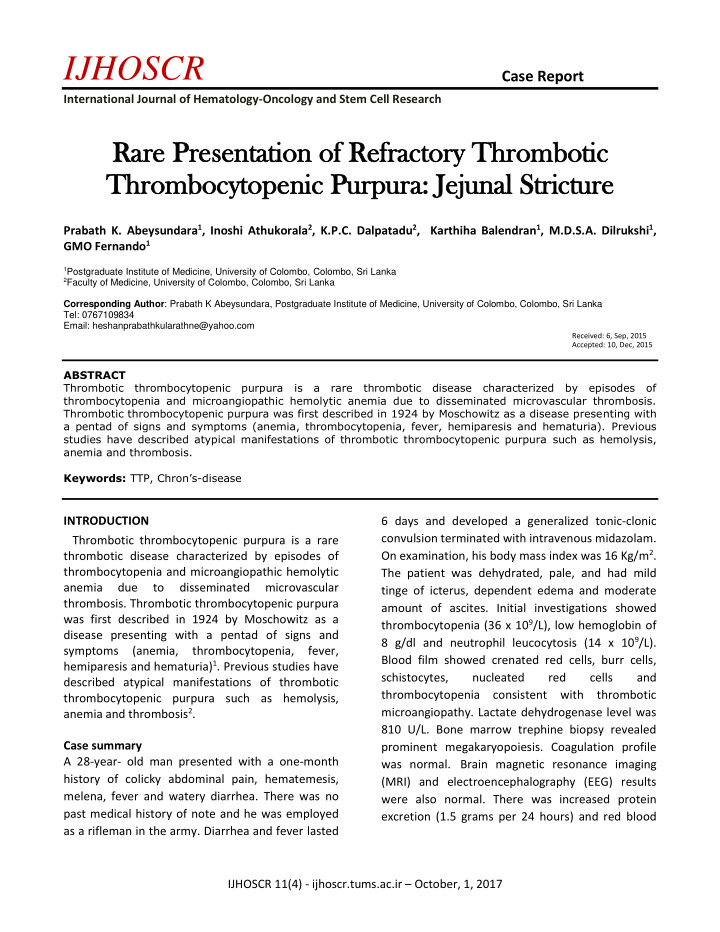



IJHOSCR Case Report International Journal of Hematology-Oncology and Stem Cell Research Rare are Presentat resentation of ion of Refr efract actor ory y Thro hrombotic botic Thr hrombocy ombocytop topen enic ic Purpur urpura: a: Jeju junal al Str tric icture ture Prabath K. Abeysundara 1 , Inoshi Athukorala 2 , K.P.C. Dalpatadu 2 , Karthiha Balendran 1 , M.D.S.A. Dilrukshi 1 , GMO Fernando 1 1 Postgraduate Institute of Medicine, University of Colombo, Colombo, Sri Lanka 2 Faculty of Medicine, University of Colombo, Colombo, Sri Lanka Corresponding Author : Prabath K Abeysundara, Postgraduate Institute of Medicine, University of Colombo, Colombo, Sri Lanka Tel: 0767109834 Email: heshanprabathkularathne@yahoo.com Received: 6, Sep, 2015 Accepted: 10, Dec, 2015 ABSTRACT Thrombotic thrombocytopenic purpura is a rare thrombotic disease characterized by episodes of thrombocytopenia and microangiopathic hemolytic anemia due to disseminated microvascular thrombosis. Thrombotic thrombocytopenic purpura was first described in 1924 by Moschowitz as a disease presenting with a pentad of signs and symptoms (anemia, thrombocytopenia, fever, hemiparesis and hematuria). Previous studies have described atypical manifestations of thrombotic thrombocytopenic purpura such as hemolysis, anemia and thrombosis. Keywords: TTP, Chron’s -disease INTRODUCTION 6 days and developed a generalized tonic-clonic convulsion terminated with intravenous midazolam. Thrombotic thrombocytopenic purpura is a rare On examination, his body mass index was 16 Kg/m 2 . thrombotic disease characterized by episodes of thrombocytopenia and microangiopathic hemolytic The patient was dehydrated, pale, and had mild anemia due to disseminated microvascular tinge of icterus, dependent edema and moderate thrombosis. Thrombotic thrombocytopenic purpura amount of ascites. Initial investigations showed was first described in 1924 by Moschowitz as a thrombocytopenia (36 x 10 9 /L), low hemoglobin of disease presenting with a pentad of signs and 8 g/dl and neutrophil leucocytosis (14 x 10 9 /L). symptoms (anemia, thrombocytopenia, fever, Blood film showed crenated red cells, burr cells, hemiparesis and hematuria) 1 . Previous studies have schistocytes, nucleated red cells and described atypical manifestations of thrombotic thrombocytopenia consistent with thrombotic thrombocytopenic purpura such as hemolysis, microangiopathy. Lactate dehydrogenase level was anemia and thrombosis 2 . 810 U/L. Bone marrow trephine biopsy revealed Case summary prominent megakaryopoiesis. Coagulation profile A 28-year- old man presented with a one-month was normal. Brain magnetic resonance imaging history of colicky abdominal pain, hematemesis, (MRI) and electroencephalography (EEG) results melena, fever and watery diarrhea. There was no were also normal. There was increased protein past medical history of note and he was employed excretion (1.5 grams per 24 hours) and red blood as a rifleman in the army. Diarrhea and fever lasted IJHOSCR 11(4) - ijhoscr.tums.ac.ir – October, 1, 2017
Prabath K. Abeysundara, et al. IJHOSCR, 1 October. Volume 11, Number 4 cells without any casts in urine. The rate of glomerular filtration was normal. Concomitantly, inflammatory markers (erythrocyte sedimentation rate, C-reactive protein) and autoimmune profile (anti-nuclear antibody, anti- dsDNA antibody, anti- Smith antibody) remained normal. Erect abdominal radiograph showed dilated small bowel loops and multiple fluid levels. Ultrasound scan of the abdomen and contrast-enhanced computed tomography revealed mural thickening of the distal ileum, caecum, and proximal ascending colon together with moderate ascites without any evidence of thoracic or abdominal lymphadenopathy. Peritoneal fluid aspirate was Figure 1. Barium meal follow-through showed an edematous stricture pale yellow, protein: 4.2 g/dl, pus cells: 12-15/ high- of the distal jejunum strongly suggestive of Crohn’s disease. power field, ADA: 16 U/L, tuberculosis PCR: Oral prednisolone 1mg/Kg and daily plasma negative. Cytology showed acute and chronic exchange of 1.5 volumes were begun. After 6 cycles inflammation with epithelioid histiocyte-like cells. of plasma exchange, platelets began to rise with Mycobacterium tuberculosis and atypical disappearance of fragmented red blood cells in mycobacterial cultures, tuberculosis interferon- blood film. Diarrhea and fever settled and the gamma in serum, pyogenic culture, anti-Yersinia patient clinically improved. After 24 cycles of antibody in serum were negative. Barium meal plasma exchange, platelet count was 160 x 10 9 /L, follow-through showed an edematous stricture of and thereafter exchanges were done every other the distal jejunum strongly suggestive of Croh n’s day, but reducing trend of platelets and disease (Figure 1). Upper gastrointestinal reappearance of gastrointestinal symptoms were observed thereafter. The diagnosis of refractory endoscopy showed inflamed mucosa extending thrombotic thrombocytopenic purpura was made from mid esophagus, stomach and beyond second and the patient was started on intravenous anti-CD part of the duodenum. Colonoscopy revealed 20 monoclonal antibodies (Rituximab) at 375/1.73 inflamed caecum, ileum and proximal ascending m 2 per week for 4 weeks. Prednisolone was tailed colon. Multiple biopsies revealed non-specific off over one month and plasma exchange was inflammation in hematoxylin and eosin stain. Fungal withheld. After 3 months of Rituximab therapy, the staining and periodic acid shift staining did not patient was asymptomatic and platelet count reveal any abnormality. Diagnostic laparoscopy remained stable around 200 x 10 9 /L. showed the inflamed appendix and appendectomy was done. Histology revealed chronic inflammation DISCUSSION Amorosi et al. described pentad of features of TTP and a thrombus in an arteriole without any including fever, bleeding or purpura generally with evidence of vasculitis. Tuberculosis culture of the thrombocytopenia, microangiopathic haemolytic appendicular biopsy was negative. anaemia, neurological manifestations, and renal On day 27 of his hospital admission, the diagnosis of disease which were demonstrated in this patient 3 . thrombotic thrombocytopenic purpura (TTP) was Radiological finding supported the diagnosis of made. Crohn’s disease. But classical endoscopic features of cobblestoning, discontinuous lesions and histological features of granulomas and 294 International Journal of Hematology Oncology and Stem Cell Research ijhoscr.tums.ac.ir
Recommend
More recommend